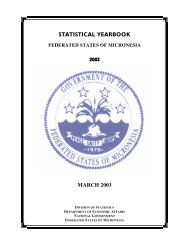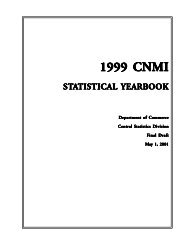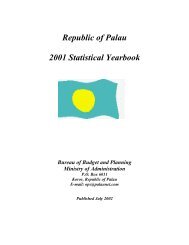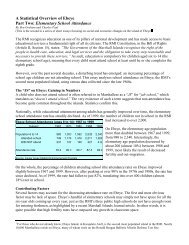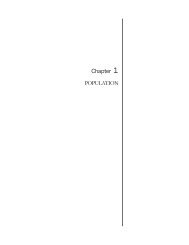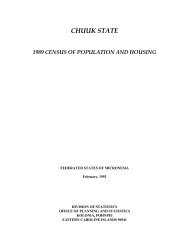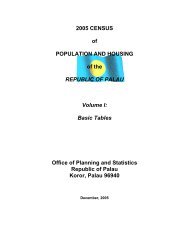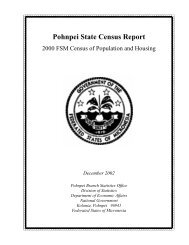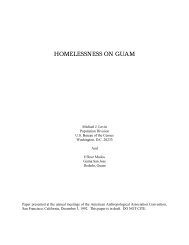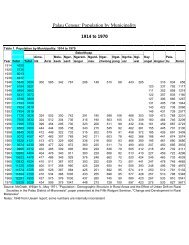Chapter 6. Migration2000 FSM <strong>Census</strong> of <strong>Chuuk</strong> <strong>State</strong>Table 6.8: Movers by Place of Previous Residence, <strong>Chuuk</strong> <strong>State</strong>: 1994 and 20001994 2000Horizontal percentHorizontal percentVertical Other FSM Else- Vertical Other FSM Else-Duration of residence Total Percent Percent <strong>Chuuk</strong> states In Asia where Number percent Percent <strong>Chuuk</strong> states In Asia whereTotal 5,964 100.0 100.0 80.6 3.9 7.9 7.6 5,317 100.0 100.0 90.5 2.9 0.8 5.8Less than 6 months 770 12.9 100.0 82.7 5.6 2.3 9.4 360 6.8 100.0 86.4 0.8 0.3 12.56 months to 1 year 409 6.9 100.0 78.7 1.2 4.6 15.4 431 8.1 100.0 73.3 10.0 1.9 14.81 to 2 years 418 7.0 100.0 72.2 7.2 4.8 15.8 417 7.8 100.0 80.1 3.1 0.5 16.32 to 5 years 540 9.1 100.0 73.7 7.6 4.8 13.9 770 14.5 100.0 88.3 2.9 1.2 7.75 years or more 3,827 64.2 100.0 82.3 3.0 10.1 4.6 3,339 62.8 100.0 94.9 2.1 0.7 2.2Source: 1994 FSM <strong>Census</strong>, Table P18; 2000 FSM 2000 FSM <strong>Census</strong>, Table P2-7.Note: Duration of residence refers to continuous residence at the municipality of usual residence.Place of Residence Five Years Prior to the <strong>Census</strong>More specific time-bound migration information was collected based on usual residence exactly five years before thecensuses. Tables 6.9 to 6.13 present this information, necessarily excluding persons less than 5 years old during therespective censuses. For many purposes, including estimating migration levels for population projections, this kind ofinformation is very useful.Table 6.9 can be interpreted in a similar way to Table 6.3, which dealt with lifetime migration. However, since theperiod covered was shorter the number of migrants is reduced. The number of immigrants from outside <strong>Chuuk</strong> haddeclined slightly from 571 for period 1989 to 1994) to 510 (for period 1995 to 2000). Likewise, internal migrants --those migrants between Lagoon and Outer Islands -- declined from 790 to 630 for the respective periods. The Lagoonis the destination of migrants from both within and outside <strong>Chuuk</strong>. For example, for period 1995 to 2000, 418 (66percent) of the internal migrants and 473 (93 percent) of the immigrants moved to the Lagoon.Table 6.9: Residence 5 Years Ago by Usual Residence for Persons Aged 5 Years and Over, <strong>Chuuk</strong> <strong>State</strong>: 1994 and 20001994 2000Residence 5 years ago Total Lagoon Outer Islands Total Lagoon Outer IslandsTotal 44,879 34,978 9,901 46,248 34,886 11,362<strong>Chuuk</strong> 44,308 34,478 9,830 45,738 34,413 11,325Lagoon 34,096 33,892 204 34,207 33,995 212Outer Islands 10,212 586 9,626 11,531 418 11,113Outside <strong>Chuuk</strong> 571 500 71 510 473 37Other FSM states 134 120 14 106 93 13USA 294 250 44 327 314 13Asia 97 96 1 22 21 1Elsewhere 46 34 12 55 45 10Source: 1994 FSM <strong>Census</strong>, Table P20; 2000 FSM <strong>Census</strong>, Table P2-8Table 6.10 summarizes the internal migration presented in Table 6.9 and compares internal migration rates betweenthe <strong>Chuuk</strong> Lagoon and the Outer Islands in between periods 1989 to 1994 and periods 1995 to 2000. The level ofmigration had decline between the two periods but the pattern is somewhat the same. A comparison of annualmigration rates per 1,000 persons for both census years indicated that the <strong>Chuuk</strong> Lagoon received more in-migrantsthan out-migrants and that the reverse was true for the Outer Islands. An advantage of specific 5-year migration isthat it permits the calculation of an annual migration rate, which measures the impact that migration has onpopulation growth. Although not as significant as census year 1994 (migration rate of about 8 percent), the impactwas greatest in the Outer Islands, where annual net out-migration accounted for about 4 per thousand of thepopulation. In other words, between 1995 and 2000, 4 out of every thousand people out-migrated to the Lagoonarea. On the other hand, the Lagoon is gaining 1 person per thousand annually in the same period.Table 6.10. Annual Internal Migration Rate by Region, <strong>Chuuk</strong> <strong>State</strong>: 1994 and 20001989 to 1994 1995 to 2000Non- In- Out- Net- Annual migration Non- In- Out- Net- Annual migrationRegion movers migrants migrants migrants rate (%) movers migrants migrants migrants rate (%)TotalLagoon 33,892 586 204 382 2.2 33,995 418 215 203 1.2Outer Islands 9,626 204 586 (382) (7.6) 11,113 215 418 (203) (3.6)MalesLagoon 17,308 280 104 176 2.0 11,414 186 100 86 1.5Outer Islands 4,846 104 280 (176) (7.0) 5,636 103 186 (83) (2.9)FemalesLagoon 16,584 306 100 206 2.5 22,581 232 112 120 1.1Outer Islands 4,780 100 306 (206) (8.3) 5,477 112 232 (120) (4.2)Source: 1994 FSM <strong>Census</strong>, Table P20 & unpublished; 2000 FSM <strong>Census</strong>, Table P2-8Note: Annual migration rate is defined as (logP2/P1)/N, where P2 is the sum of non-movers and in-migrants, P1 is the sum of non-movers and out-migrants, and N isthe number of years in the defined period.54 <strong>Chuuk</strong> Branch Statistics Office, Division of Statistics, FSM Department of Economic Affairs
2000 FSM <strong>Census</strong> of <strong>Chuuk</strong> <strong>State</strong>Chapter 6. MigrationTable 6.11 summarizes the interstate migration presented in Table 6.9 and compares interstate migration rates betweenthe <strong>Chuuk</strong> Lagoon and other FSM states between periods 1989 to 1994 and periods 1995 to 2000. Over the twoperiods, an increasing number of <strong>Chuuk</strong>ese have migrated out of <strong>Chuuk</strong> to other FSM states, particularly to Pohnpei.On the other hand, the number of people moved into <strong>Chuuk</strong> from the other FSM states decreased slightly from 134 to110.Table 6.11: Residence Five Years Ago by Usual Residence for Persons 5 Years and Over, <strong>Chuuk</strong> <strong>State</strong>: 1994 and 20001994 2000Residence 5 years ago Total <strong>Chuuk</strong> Yap Pohnpei Kosrae Total <strong>Chuuk</strong> Yap Pohnpei KosraeTotal 87,531 44,442 9,228 27,854 6,007 90,022 45,845 9,194 28,602 6,381<strong>Chuuk</strong> 44,616 44,308 31 265 12 46,140 45,738 19 356 27Yap 9,256 20 9,148 86 2 9,259 10 9,114 131 4Pohnpei 27,551 103 42 27,329 77 28,345 92 60 27,999 194Kosrae 6,108 11 7 174 5,916 6,278 5 1 116 6,156Source: 1994 FSM <strong>Census</strong>, Table P20; 2000 FSM <strong>Census</strong>, Table P2-8Table 6.12 presents educational attainment of in-migrants from other FSM states for periods 1989 to 1994 and 1995 to2000. The percentage of all in-migrant who graduated high school increased from 19 percent in 1994 to 39 percent in2000. In 2000, the percentages of males and females with attainment of high school or more was about 36 percent and38 percent respectively, suggesting that female in-migrants from the other FSM states tended to be better educated thantheir male counterparts.Table 6.12: Educational Attainment of Interstate Migrants by Sex, <strong>Chuuk</strong> <strong>State</strong> 1994 and 20001989-1994 1995-2000Number Percent Number PercentEducational Attainment Total Males Females Total Males Females Total Males Females Total Males FemalesTotal 134 86 48 100.0 100.0 100.0 110 78 32 100.0 100.0 100.0No education 10 6 4 7.5 7.0 8.3 5 3 2 4.5 3.8 6.3Elementary 28 16 12 20.9 18.6 25.0 22 13 9 20.0 16.7 28.1High school no diploma 70 50 20 52.2 58.1 41.7 43 34 9 39.1 43.6 28.1High school graduate 9 6 3 6.7 7.0 6.3 15 11 4 13.6 14.1 12.5College 17 8 9 12.7 9.3 18.8 25 17 8 22.7 21.8 25.0Source: 1994 & 2000 FSM <strong>Census</strong>es, unpublished data.Table 6.13 compares the labor force characteristics of the in-migrants by age groups. The table illustrates that thepercentage of in-migrants in the labor force increased 21 percent for period 1989-1994 to 53 percent for period 1995-2000. Furthermore, the employment rate among these migrants increased from 86 percent to 96 percent. In 2000, allof the migrants who were not in the labor force could not have taken a job, even if it was offered. These were probablystudents and spouses of working migrants.Table 6.13: Labor Force Participation of Interstate Migrants by Sex, <strong>Chuuk</strong> <strong>State</strong> 1994 and 2000In the labor force (LF)Not in the labor forceEmployed Unemployed Could have taken a job Not available for workAge group Total Total Number % in LF Number % in LF Total Number % not in LF Number % not in LF1994Total 106 22 19 86.4 3 13.6 84 5 6.0 79 94.015-29 years 87 12 9 75.0 3 25.0 75 5 6.7 70 93.330-44 years 12 7 7 100.0 - - 5 - - 5 100.045-59 years 5 3 3 100.0 - - 2 - - 2 100.065+ years 2 - - - - - 2 - - 2 100.02000Total 93 49 47 95.9 2 4.1 44 - - 44 100.015-29 years 51 10 9 90.0 1 2.0 41 - - 41 100.030-44 years 22 20 20 100.0 - - 2 - - 2 100.045-59 years 18 17 16 94.1 1 2 1 - - 1 100.065+ years 2 2 2 100.0 - - - - - - -Source: 1994 & 2000 FSM <strong>Census</strong>es, unpublished<strong>Chuuk</strong> Branch Statistics Office, Division of Statistics, FSM Department of Economic Affairs 55
- Page 5:
iii
- Page 12 and 13:
Preface2000 FSM Census of Chuukx
- Page 14 and 15:
Table of contents2000 FSM Census of
- Page 16 and 17:
LIST OF TEXT TABLESTABLEPageChapter
- Page 18 and 19:
List of Text Table2000 FSM Census o
- Page 20 and 21:
LIST OF FIGURESFIGUREPageFigure 1.1
- Page 22 and 23:
List of Basic-Tables2000 FSM Census
- Page 24 and 25:
MAP OF FSMxxiiChuuk Branch Statisti
- Page 27 and 28:
2000 FSM Census of Chuuk StateExecu
- Page 29 and 30:
CHAPTER 1INTRODUCTIONThe creation o
- Page 31 and 32: 2000 FSM Census of Chuuk StateChapt
- Page 33 and 34: 2000 FSM Census of Chuuk StateChapt
- Page 35 and 36: 2000 FSM Census of Chuuk StateChapt
- Page 37 and 38: 2000 FSM Census of Chuuk StateChapt
- Page 39 and 40: 2000 FSM Census of Chuuk StateChapt
- Page 41 and 42: 2000 FSM Census of Chuuk StateChapt
- Page 43 and 44: 2000 FSM Census of Chuuk State Chap
- Page 45: 2000 FSM Census of Chuuk StateChapt
- Page 48 and 49: Chapter 2. Age and Sex Structure200
- Page 50 and 51: Chapter 2. Age and Sex Structure200
- Page 52 and 53: Chapter 2. Age and Sex Structure200
- Page 55 and 56: CHAPTER 3HOUSEHOLDS, FAMILIES, AND
- Page 57 and 58: 2000 FSM Census of Chuuk StateChapt
- Page 59 and 60: 2000 FSM Census of Chuuk StateChapt
- Page 61: 2000 FSM Census of Chuuk StateChapt
- Page 64 and 65: Chapter 4. Fertility2000 FSM Census
- Page 66 and 67: Chapter 4. Fertility2000 FSM Census
- Page 68 and 69: Chapter 4. Fertility2000 FSM Census
- Page 71 and 72: CHAPTER 5MORTALITYIntroductionAs re
- Page 73 and 74: 2000 FSM Census of Chuuk StateChapt
- Page 75: 2000 FSM Census of Chuuk StateChapt
- Page 78 and 79: Chapter 6. Migration2000 FSM Census
- Page 80 and 81: Chapter 6. Migration2000 FSM Census
- Page 84 and 85: Chapter 6. Migration2000 FSM Census
- Page 86 and 87: Chapter 7. Religion, Ethnicity, and
- Page 88 and 89: Chapter 7. Religion, Ethnicity, and
- Page 90 and 91: Chapter 7. Religion, Ethnicity, and
- Page 92 and 93: Chapter 8. Education2000 FSM Census
- Page 94 and 95: Chapter 8. Education2000 FSM Census
- Page 96 and 97: Chapter 8. Education2000 FSM Census
- Page 98 and 99: Chapter 8. Education2000 FSM Census
- Page 100 and 101: Chapter 8. Education2000 FSM Census
- Page 103 and 104: CHAPTER 9ECONOMIC ACTIVITYIntroduct
- Page 105 and 106: 2000 FSM Census of Chuuk StateChapt
- Page 107 and 108: 2000 FSM Census of Chuuk StateChapt
- Page 109 and 110: 2000 FSM Census of Chuuk StateChapt
- Page 111 and 112: 2000 FSM Census of Chuuk StateChapt
- Page 113 and 114: 2000 FSM Census of Chuuk StateChapt
- Page 115 and 116: 2000 FSM Census of Chuuk StateChapt
- Page 117 and 118: CHAPTER 10INDUSTRY AND OCCUPATIONIn
- Page 119 and 120: 2000 FSM Census of Chuuk StateChapt
- Page 121 and 122: 2000 FSM Census of Chuuk StateChapt
- Page 123 and 124: 2000 FSM Census of Chuuk StateChapt
- Page 125 and 126: 2000 FSM Census of Chuuk StateChapt
- Page 127 and 128: 2000 FSM Census of Chuuk StateChapt
- Page 129 and 130: CHAPTER 11INCOMEIntroductionThe 200
- Page 131 and 132: 2000 FSM Census of Chuuk StateChapt
- Page 133 and 134:
2000 FSM Census of Chuuk StateChapt
- Page 135 and 136:
2000 FSM Census of Chuuk StateChapt
- Page 137:
2000 FSM Census of Chuuk StateChapt
- Page 140 and 141:
Chapter 12. Housing2000 FSM Census
- Page 142 and 143:
Chapter 12. Housing2000 FSM Census
- Page 144 and 145:
Chapter 12. Housing2000 FSM Census
- Page 146 and 147:
Chapter 12. Housing2000 FSM Census
- Page 148 and 149:
Chapter 12. Housing2000 FSM Census
- Page 150 and 151:
Chapter 12. Housing2000 FSM Census
- Page 152 and 153:
Chapter 12. Housing2000 FSM Census
- Page 154:
Chapter 12. Housing2000 FSM Census
- Page 157 and 158:
BIBLIOGRAPHYArriaga, E.E., (1983).
- Page 159:
2000 FSM Census of Chuuk StateBibli
- Page 162 and 163:
Basic Tables2000 FSM Census of Chuu
- Page 164 and 165:
Basic Tables2000 FSM Census of Chuu
- Page 166 and 167:
Basic Tables2000 FSM Census of Chuu
- Page 168 and 169:
Basic Tables2000 FSM Census of Chuu
- Page 170 and 171:
Basic Tables2000 FSM Census of Chuu
- Page 172 and 173:
Basic Tables2000 FSM Census of Chuu
- Page 174 and 175:
Basic Tables2000 FSM Census of Chuu
- Page 176 and 177:
Basic Tables2000 FSM Census of Chuu
- Page 178 and 179:
Basic Tables2000 FSM Census of Chuu
- Page 180 and 181:
Basic Tables2000 FSM Census of Chuu
- Page 182 and 183:
Basic Tables2000 FSM Census of Chuu
- Page 184 and 185:
Basic Tables2000 FSM Census of Chuu
- Page 186 and 187:
Basic Tables2000 FSM Census of Chuu
- Page 188 and 189:
Basic Tables2000 FSM Census of Chuu
- Page 190 and 191:
Basic Tables2000 FSM Census of Chuu
- Page 192 and 193:
Basic Tables2000 FSM Census of Chuu
- Page 194 and 195:
Basic Tables2000 FSM Census of Chuu
- Page 196 and 197:
Basic Tables2000 FSM Census of Chuu
- Page 198 and 199:
Basic Tables2000 FSM Census of Chuu
- Page 200 and 201:
Basic Tables2000 FSM Census of Chuu
- Page 202 and 203:
Basic Tables2000 FSM Census of Chuu
- Page 204 and 205:
Basic Tables2000 FSM Census of Chuu
- Page 206 and 207:
Basic Tables2000 FSM Census of Chuu
- Page 208 and 209:
Basic Tables2000 FSM Census of Chuu
- Page 210 and 211:
Basic Tables2000 FSM Census of Chuu
- Page 212 and 213:
Basic Tables2000 FSM Census of Chuu
- Page 214 and 215:
Basic Tables2000 FSM Census of Chuu
- Page 216 and 217:
Basic Tables2000 FSM Census of Chuu
- Page 218 and 219:
Basic Tables2000 FSM Census of Chuu
- Page 220 and 221:
Basic Tables2000 FSM Census of Chuu
- Page 222 and 223:
Basic Tables2000 FSM Census of Chuu
- Page 224 and 225:
Basic Tables2000 FSM Census of Chuu
- Page 226 and 227:
Basic Tables2000 FSM Census of Chuu
- Page 228 and 229:
Basic Tables2000 FSM Census of Chuu
- Page 230 and 231:
Basic Tables2000 FSM Census of Chuu
- Page 232 and 233:
Basic Tables2000 FSM Census of Chuu
- Page 234 and 235:
Basic Tables2000 FSM Census of Chuu
- Page 236 and 237:
Basic Tables2000 FSM Census of Chuu
- Page 238 and 239:
Basic Tables2000 FSM Census of Chuu
- Page 240 and 241:
Basic Tables2000 FSM Census of Chuu
- Page 242 and 243:
Basic Tables2000 FSM Census of Chuu
- Page 244 and 245:
Basic Tables2000 FSM Census of Chuu
- Page 246 and 247:
Basic Tables2000 FSM Census of Chuu
- Page 248 and 249:
Basic Tables2000 FSM Census of Chuu
- Page 250 and 251:
Basic Tables2000 FSM Census of Chuu
- Page 252 and 253:
Basic Tables2000 FSM Census of Chuu
- Page 254 and 255:
Basic Tables2000 FSM Census of Chuu
- Page 256 and 257:
Basic Tables2000 FSM Census of Chuu
- Page 258 and 259:
Basic Tables2000 FSM Census of Chuu
- Page 260 and 261:
Basic Tables2000 FSM Census of Chuu
- Page 262 and 263:
Basic Tables2000 FSM Census of Chuu
- Page 264 and 265:
Basic Tables2000 FSM Census of Chuu
- Page 266 and 267:
Basic Tables2000 FSM Census of Chuu
- Page 268 and 269:
Basic Tables2000 FSM Census of Chuu
- Page 270 and 271:
Basic Tables2000 FSM Census of Chuu
- Page 272 and 273:
Basic Tables2000 FSM Census of Chuu
- Page 274 and 275:
Basic Tables2000 FSM Census of Chuu
- Page 276 and 277:
Basic Tables2000 FSM Census of Chuu
- Page 278 and 279:
Basic Tables2000 FSM Census of Chuu
- Page 280 and 281:
Basic Tables2000 FSM Census of Chuu
- Page 282 and 283:
Basic Tables2000 FSM Census of Chuu
- Page 284 and 285:
Basic Tables2000 FSM Census of Chuu
- Page 286 and 287:
Basic Tables2000 FSM Census of Chuu
- Page 288 and 289:
Basic Tables2000 FSM Census of Chuu
- Page 290 and 291:
Basic Tables2000 FSM Census of Chuu
- Page 292 and 293:
Questionnaire2000 FSM Census of Chu
- Page 294 and 295:
Questionnaire2000 FSM Census of Chu
- Page 296 and 297:
Questionnaire2000 FSM Census of Chu



